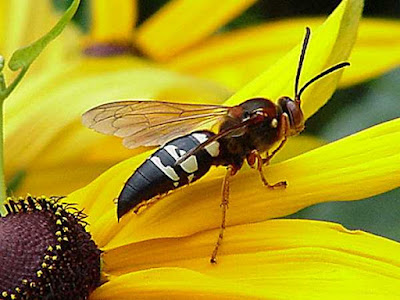The Life of Animals | Wasp | In Wasps, as in other Hymenoptera, sexes are significantly genetically different. Females have 2n number of chromosomes and come about from fertilized eggs. Like all Insects, Wasps have a hard exoskeleton covering Their three main body parts. Like all Insects, Wasps have three sets of two legs. Male yellow jacket Wasps, for example, have 13 divisions per antenna, while females have 12. The difference the between sterile female worker Wasps and queens also varies Generally the between species but the queen is noticeably larger than females and other males Both.
Wasps can be differentiated from bees, the which have a flattened Hind basitarsus. Unlike bees, Wasps Generally lack plumose hairs. Generally Wasps are Parasites or parasitoids as larvae, and feed only on nectar as adults. Many Wasps are predatory, using other Insects (Often paralyzed) as food for Their larvae. A few social Wasps are omnivorous, feeding on a variety of fallen fruit, nectar, and carrion. Adult male Sometimes Wasps visit flowers to Obtain nectar to feed on in much the same manner as honey bees. Occasionally,
some species, Such as Yellowjackets and, ESPECIALLY, Hornets, invade honey bee Nests and steal honey and / or Brood The type of nest produced by Wasps can depend on the species and location. Many social Wasps Nests That Produce are constructed predominantly from paper pulp. Social Wasps also use other types of nesting material mixed in with That Become the nest and it is common to find Nests located near to the plastic pool or trampoline covers incorporating distinct bands of color That Reflect the inclusion of these materials have simply been That chewed up and mixed with wood fibers to give a unique look to the nest. Again each species of social wasp Appears to favour its own specific range of nesting sites.
By contrast Generally solitary Wasps are parasitic or predatory and only the latter build Nests at all. Unlike honey bees, Wasps have no wax producing glands. The Nests of some social Wasps, Hornets Such as, are first constructed by the queen and reach about the size of a walnut before sterile female workers take over construction. The queen initially starts the nest by making a single layer or canopy and working outwards until She reaches the edges of the cavity. What has also been seen Nests are close to one another at the beginning of the year Quickly growing and merging with one another to create Nests with TENS of Thousands of workers.Polistes Some related types of paper wasp do not construct Their Nests in tiers but rather in flat single Combs.
Not all social castes That Wasps have are physically different in size and structure. In many papers polistine Wasps and stenogastrines, for example, the castes of females are determined behaviorally, through dominance interactions, rather than having caste predetermined. All female Wasps are Potentially capable of Becoming a colony's queen and Often this process is determined by the which female successfully lays eggs first and begins construction of the nest. Evidence Suggests That Compete females amongst each other by eating the eggs of other rival females. Once the first eggs have hatched, the subordinate females stop laying eggs and instead forage for the new queen and feed the young; That is, the competition largely ends, with the losers Becoming workers, though if the dominant female dies, a new hierarchy may be established with a former "worker" acting as the replacement queen. Nests are considerably Polistine Smaller than many other social wasp Nests, typically housing only around 250 Wasps, compared to the Several thousand common with Yellow jackets, and stenogastrines have the smallest Colonies of all, rarely with more than a dozen Wasps in a mature colony.















Post a Comment